In this article, I’ll share a practical and actionable renewal management strategy that enables you to identify and escalate accounts at risk of churn.
I’ll discuss how we can make a renewal management framework that allows us to scale across these segments and use cases, and finally, the importance of accuracy and forecasting and how you can make sure you’re doing it appropriately.
My name's Kaitlyn Bate and in this article, I am going to be talking about a guide to B2B customer renewals.
About me
I am the Global Director of Customer Experience Strategy at Freshworks. In this role, I report to the Chief Customer Officer and our function oversees onboarding, customer success, and customer support.
I drive all of the strategies and initiatives that go along the lines of streamlining and figuring out our playbooks and whatever it is we want to do consistently for all of our customers across all of our segments and regions.
Prior to that, I worked as the Director of Product and Customer Success at AnswerIQ, which is an AI startup for customer support. We were acquired in January 2020 from Freshworks and this was an exciting opportunity that taught me a lot as we moved into Freshworks.
Prior to that, I spent 10 years in the HR tech space in a variety of product roles, most of the time, but I spent about two years at the start of my career in account management. We didn't really call it customer success at that time but really, it was that same spirit of what a true customer success manager is today.
About Freshworks
Freshworks offers customers for life software. We have three pillars that we focus on:
- A CRM for sales marketing,
- A CX, customer experience, for customer support, help desk, chat, caller, and a customer success solution,
- As well as employee experience so IT management and other tools you use to manage your internal employees.
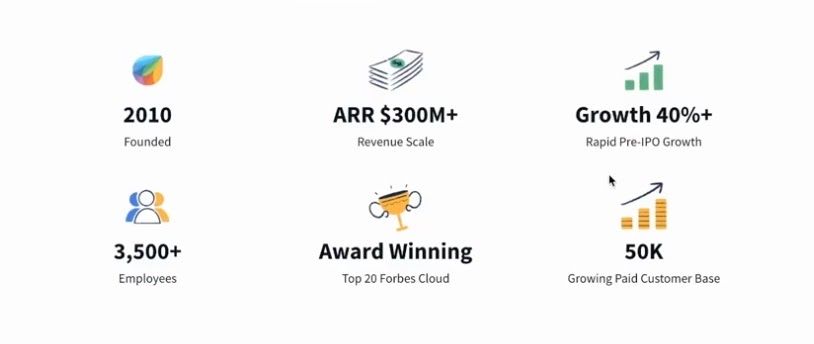
We started in 2010 and we have revenue of over $300 million ARR.
I think this is really useful session because we have 50,000 customers that are paid customers, we have 1000s more free customers. We started as an SMB provider and we've had to figure out as we move more upmarket, how do we scale and make sure we continue to offer solutions that are scalable across SMBs, globally, as well as with these different product lines and focuses?
In terms of the customer experience group, which is what our team is, we have a little over 500 employees within that group, again in onboarding, customer success, and customer support. Those are across North America, Europe, India, Australia, etc.
The agenda
Now a little bit about what you can expect from this article.
A practical and actionable renewal management strategy that enables you to identify and escalate accounts at risk of churn. This is super important, that identifying the at-risk component and getting ahead of it before they churn.
Then scaling. I talked about this a little bit already but how do we make a renewal management framework that will allow us to scale across these segments and use cases?
Accuracy and forecasting - accuracy is everything and I'll talk about this a bit. But over forecasting and under forecasting are both signs you don't really know your business. How do you make sure you are forecasting appropriately?
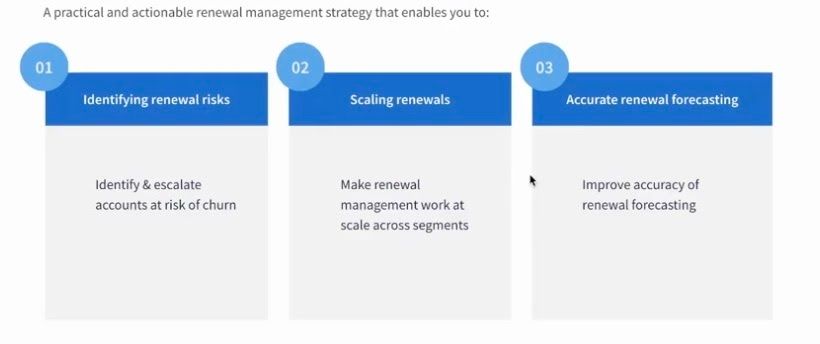
I'm going to start with a standard framework lifecycle that you guys are probably familiar with, but talk about some of the really key points that are super important.
Renewals start on day one
The first one is that renewals start on day one. It's not something right before the renewal that happens, you have to manage renewals from that very first day.
Onboarding
We think about the first stage being onboarding, your goal here is to minimize the time to value. A customer comes to you with some promise that they were given. They have some goal, something they're trying to solve.
Typically, we see these in three forms. Somebody is trying to overtime, save money, make money, or improve efficiency or productivity. Understanding really why they came to you, why they wanted your services, and what was the promise that was sold to them is critical.
When we think about the customer success role, success is in the title, right? So regardless of what your company does around commercial conversations, as a CSM your job is to make the customer successful with what they've purchased and understand what they're trying to achieve.
The first thing we want to do is minimize that payback period that it takes them to see any of that value for the investment they've made within your company.
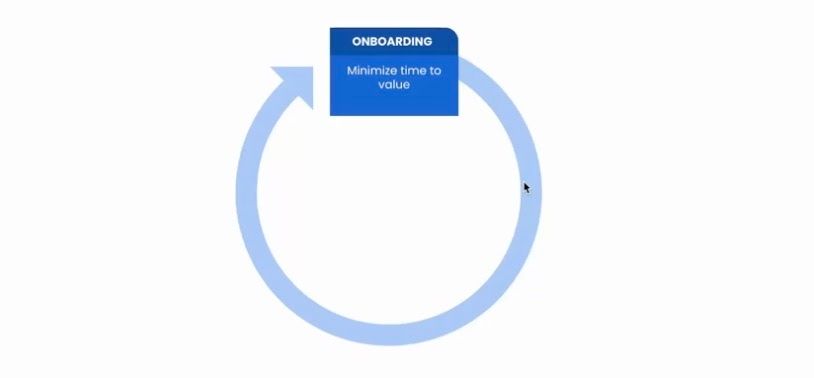
Adoption
The second thing is adoption. So the first one is about minimizing that time to value, letting them see some of that value, and then it's about really maximizing that value, and making sure they are really getting the most out of the solutions.
We have a maturity index we look across, so across all our product lines, we say we have an essential, advanced, and ultimate maturity index and we pair that across goals.
The customer is trying to achieve certain goals within each of these products. We want to be able to understand where are they at with what they're trying to achieve, and the products and features they're using?
These are things the CSMs will commonly drive conversations around, "If your goal is to do this, these are the key features that you should be using".
When we think about our essential features, it's something we look at it as if a customer is not using these Minimum Viable features, that would make it sticky, it's more likely that they're going to churn.
Within your business, if you think about what are those core things that over time, customers who haven't churned are commonly using these things, it's really helpful for us to drive value and it gives the CSMs content when they reach out to the customers.
It's a value add conversation. It also allows them to benchmark and say, "Other customers that are like you are doing this, and here are the results that they're seeing". Really just all about driving value.
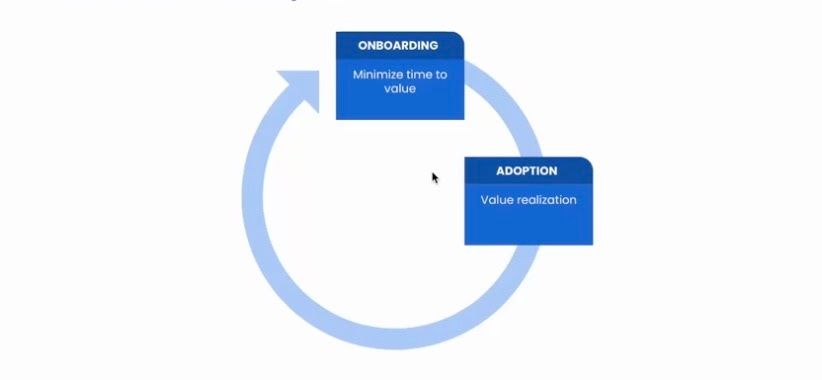
Nurture
Then we get to nurture. You've gotten to the point where the customer has gone live, they have adopted the product. Now it's about nurturing that process. This is super important because you can't just do a one and done you have to continually find moments to wow your customers.
You need to be able to show them value across time in different points in time. But then you also want to be able to do things like getting a commitment from the customer.
An example of this is, can you get the customer to go public with you, and to be an advocate? Because that actually represents a different level of commitment and engagement with you, when they are willing to be a testimonial and put their names on it that shows there is that commitment there.
It would be harder to not renew if they already put themselves out there.
Other conversations that are really important in these nurture phases, of course, we want to do the traditional QBRs and EBRs but it is so important to make sure you've got somebody with a seat at the table that you know they're the decision-maker.
You want to know, what are your strategic goals? And what's your strategic roadmap? Where are you going and is Freshworks [or insert your company name] a part of that future?
If not, give yourself time, ask six months prior to the renewal, or whatever it may be. So there's an opportunity to go and actually mitigate that potential risk.
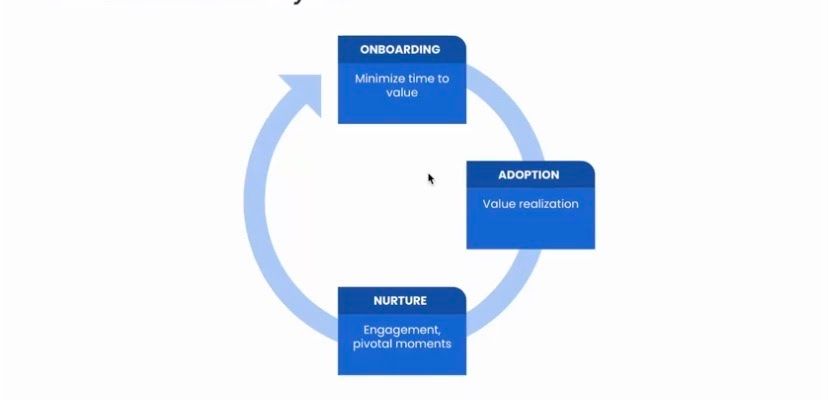
Renewal
Then have conversations outside of your QBR and EBR where they may expect it, in a monthly operational review, ask them something like, "If we were to ask you to renew your contract today, with our current terms, as it stands, what would be your answer?".
Be able to understand those pain points and those friction points that the customer is experiencing, but they may not be articulating to you very well. Know there's always going to be a threat of competition.
The customer thinks maybe they've outgrown you, they've gotten bigger, and their needs are greater. Or maybe the customer thinks there are new trends, there's AI, ML, in my experience at the startup, this is something we were doing, disrupting this experience.
There's always going to just be the competitors, they're going to come in, they're going to offer a lower price or whatever it may be. But if you've got that right relationship and engagement, you can try and mitigate that and have those conversations to make sure the customer isn't going forward and entertaining those competitive threats.
Also really starting early. Again, it starts on day one but making sure you are not reaching out right before the renewal and saying, "Okay, we're ready for your renewal", these things can take time and there can be a lot of friction in the process.
They may need procurement, there may be price escalations if they need to go back and negotiate on your appeal number, whatever it is, you want to make sure when that renewal comes, it's done on time, or ideally, it's actually done early.
Establishing a frictionless process because you're doing all of this work ahead of time.
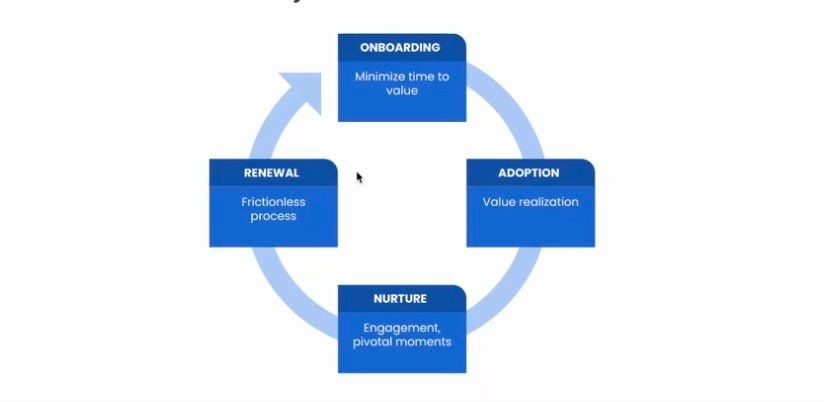
Common pain points around renewals
I'm sure you guys are keenly aware of these things.
Identifying at risk customers
Obviously from your relationships, you'll have some ideas, but what are the things you can do in the product and in these other intelligence systems that tell you what's going on with the customer that you may not see with the naked eye but be able to identify where these customers are at risk. I'll talk about that more
Visibility of renewal terms
I'm not sure if you guys experience this, but we have customers who are on monthly terms, annual terms, quarterly, semi-annual, some are on auto-renew, some are not on annual auto-renew, they're on manual.
Understanding the complexity of all those things and really having that visibility of when is this customer's true renewal coming up is something that sometimes our teams struggle with.
Silent detractors
These are their customers that act like everything's fine, they're pleasant, they're polite, they have requested, and sometimes it's easy, to use the adage the squeaky wheel gets the grease, to focus on the customers that are making the most noise and saying, "Oh, well, this customer's fine, we can deprioritize this because they're so polite".
But those things grow and those things build over time. Those customers, while they may be acting polite, could be the greatest risks because you're pushing it to the side.
So making sure you get proactive and get in front of those things. Really getting to be a more proactive CSM role instead of a firefighting mode allows you to get in front of these silent detractors.
Friction in the process
This is something we spent a lot of time talking about and focusing on. How do we make sure we get out of our own way, reducing the friction, either internally or externally or both? Where can we add self-service for the customer?
Or if we can't give it to the customer, can we give it to the CSM? How can we make sure we are making this as seamless as possible and not making it harder than it needs to be? Because already getting a renewal is something you want to make as seamless as possible.
Ambiguity of decision-maker
It's extremely important to understand who is the decision-maker? You may think you've got a champion, but ultimately, a lot of times the decision-maker is somewhere in the C suite.
From a budget standpoint, the average company has hundreds of SaaS solutions they're using so they're looking for ways to reduce redundancies, streamline, or reduce the number of vendors.
Being on top of those things, having that relationship, or at least that visibility into who's the decision-maker, what are their goals, what are their priorities, what makes them successful, is important to be able to mitigate that risk.
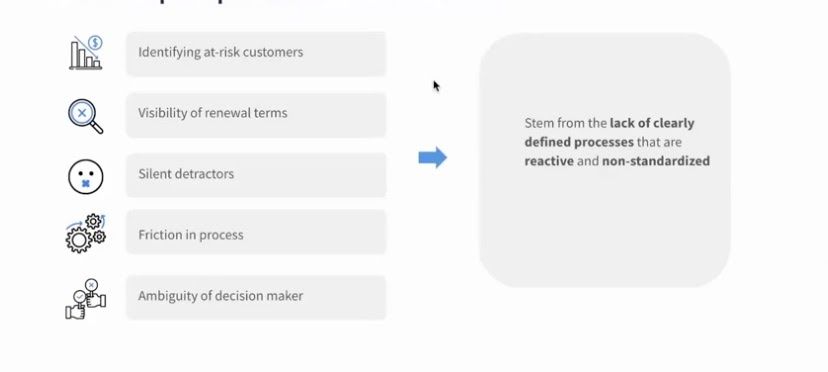
All this stems from the lack of having clearly defined processes that are reactive and non-standardized.
That was a framework concept. Now I'm going to walk you through how we do our renewals and implementation.
Freshworks implementation framework
Aggregate customer data
It is impossible to work out of static sheets, you've got to have a place where you can see all of your customer data in one place. You need to know what's going on with your customers and it's very hard to do that if things aren't coming in real-time.
Segment and prioritize
Understand context
Who needs our help? Understanding who needs your help and why they need your help and where do they need your help and making sure you've got rules and things that allow you to do this at scale is extremely important. I'll talk more about these a little bit more shortly.
This will give you insights into your customer health, and give you those triggers and events you need to know that you need to go follow up.
Manage engagement/renewal
How do we help them? This is all about our playbooks. We have grown exponentially over the last year, our customer success team, I think we've hired about 150 different new CSMs in the last six months alone.
So how do you make sure you've got an infrastructure that supports scale? At the same time, you can't always just add more people to solve your growing customer base, you need to make sure you've got the infrastructure again, to do a lot of these things for self-service at scale automation, email triggers, etc.
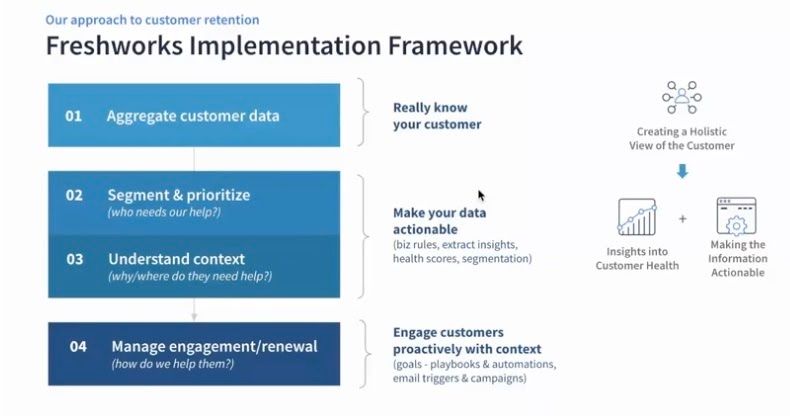
How do we unify our customer data?
We do have a customer success platform called Freshsuccess that we use, and that's here at the center but there are other providers out there.
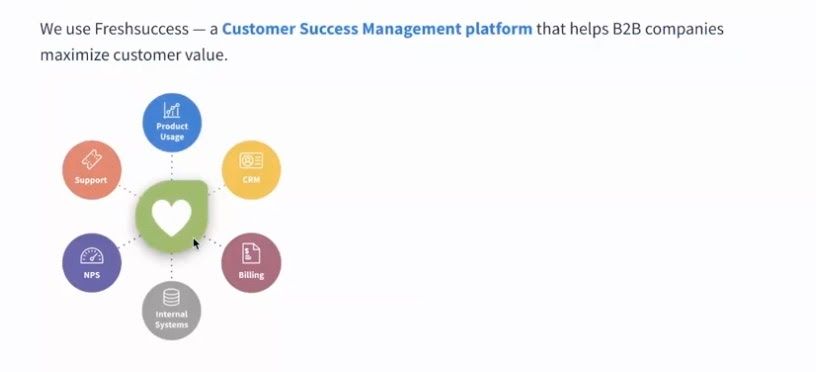
The goal is ultimately that you just need some system where you can centralize all of your information about your customer.
What we feed into Freshsuccess:
- Product usage,
- Our CRM information,
- Billing information,
- Internal systems, there are other integrations,
- NPS from our third-party provider,
- Our support tickets.
Then there are fields where the CSM can go in and they can enter fields as well.
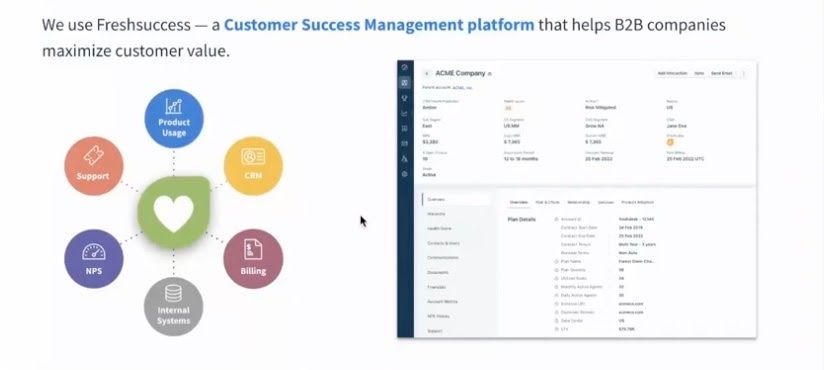
What this does is creates this customer view count 360, which allows us to see all of these different inputs, which gives you a much better picture of what's going on.
I know this sounds like a pretty simple first step but it is such a critical step that you get this information into one source, otherwise, you're missing out on critical information.
It also allows you to do things like building a health score because you've got different inputs you can use in your calculations.
How we segment our customers
When we think about how we segment our customers, they say at most companies 20% of your customers drive 80% of your revenue. So while all customers are important, we have to segment them to figure out where do we invest our people versus where do we invest our tech? To make sure that they're getting the solutions that they need.
We segment ours into three different segments.
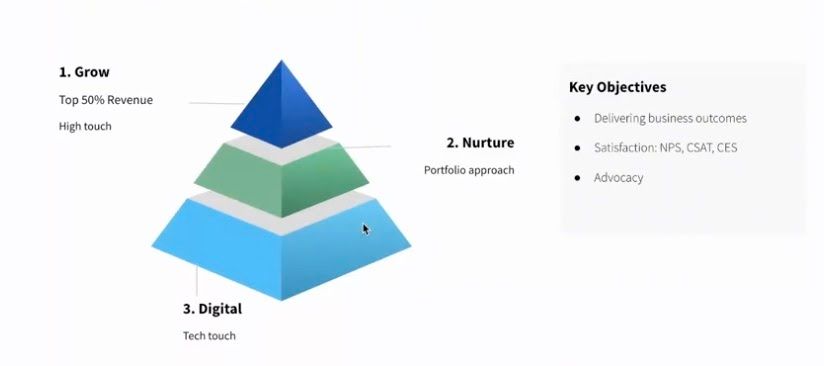
Grow
We've got our growth segment that is really focused, the top couple of thousand customers, where their CSM's high touch, in-region, close by so that when things open up again, they'll be able to go and meet those customers in person and really build some of that report.
These are smaller account books, but there's a lot of focus and all of them are focused on delivering business outcomes, satisfaction, whether that's NPS, CSAT, customer effort score, and advocacy.
Nurture
The second tier is a portfolio approach. These are larger books than that growth segment but these are dedicated CSMs. They've got about 100 accounts in this segment, and they focus on doing things more one-to-many, as opposed to one to one.
Digital
Then we've got our digital segment where we have the bulk of our customer base, we do have digital success managers who are not assigned and dedicated to a customer as a customer success manager, but they're able to help the customers.
We do outbound and inbound motions with those customers. But really, we're trying to solve for those things with the tech touch.
Why is risk assessment crucial?
We want to identify these behavior patterns of customers who are likely to downgrade or churn. But it's also super important to understand if the churn is controllable or not.
If it's not controllable, it's not a good use of your time to focus your efforts there. And your management teams not going to necessarily want to hear about all of the noncontrollable churns as well.
Controllable
It's important to know they're coming, but what the team wants to know to build a tighter team and rally around is the controllable ones, support risks, product risks, feature promises that hadn't been delivered, these are the things they can help influence and mitigate.
They can build rapport, you can bring in your team and their team if you need to get in there and escalate things.
Non-controllable
But there are times when the churn is not controllable. Acquisition, strategy changing direction where you just can't have influence over it.
Those aren't the best use of your time because there's not a lot you can do. Really understanding this is the segment we want to focus on. It's also important we have tools.
In the system, you want to be able to have all of these product inputs and these things that red flag you and create alerts, when there are churn potential risks. But you also want the CSM to be able to put in there anything that's at risk as well.
Is this customer potentially at risk because of those noncontrollable things that wouldn't show up within the system? Strategy changing direction, stakeholder change and you need to make sure you get better alignment with the other contacts within the business, etc.
Create playbook and track progress against the target metrics
The next step is we create playbooks and we track progress against these and we're always iterating, we're continually trying to improve and figure out what's working, A/B testing, etc.
As I said, we've hired 150 new CSMs over the last six months, we want to make sure we've created standardized task playbooks that tell them exactly "Here are the steps that you do when this is an alert that gets triggered to you", or having goals within the system.
These are internal goals, what we want to accomplish with the customer, and then these are the customers’ goals, these are unique to each customer, but what is the customer trying to achieve?
Establishing what are those steps so you work towards them and there are tasks and things you keep track of, and you don't lose sight of them.
Because again, it all comes back to the fact a renewal starts on day one and is something you're continually trying to show value and create those moments of Wow, with the customer to make sure they are in place that you are adding value and they are renewing.
Engage the right customer at the right time
This is where, especially as we think about our tech touch, we want to make sure we've got scalability automation with email triggers, etc.
When we're dealing with a grow account, it's more one-on-one, the CSM may not use some automated message. But as we have to segment, this is one of the ways that you can reach out to your customers that are more in a tech touch segment.
Precise forecasting is the key to success
I know I mentioned this earlier, but it is really bad when you over forecast or under forecast your churn because it shows that you don't know your business.
You don't know what's going on and you are having a hard time mitigating all of these things that are going on. This is something that's super important to refine and hone to understand what are the churn risks?
The churn summary - I spend a tonne of my time on churn summary and churn trends and understanding what's the data telling us? How many customers are churning because of certain reasons? And then let's take that back to the different functions, the support org, the product org, and implement changes so we stop having customers that leave for these reasons.
To recap
Really what I want you to take away:
- Customer renewal starts on day one.
- Customer retention is a team effort.
We always say that churn is a company problem, and it's everyone's problem within the company. It's not fair to put that just on a CSM alone, we all need the teams and the resources to make sure we're continually driving value for the customer.
That we understand what their strategic goals are and how we fit in as a provider so that we can always be tweaking and adjusting to making sure we are offering those things. And finally,
- Accurate renewal forecasting is the key to customer success.
Thank you.



